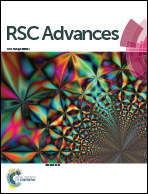Ag@ZIF-8/g-C3N4 Z-scheme photocatalyst for the enhanced removal of multiple classes of antibiotics by integrated adsorption and photocatalytic degradation under visible light irradiation†
Abstract
By combining the plasmon resonance of Ag nanoparticles and orientation effects of ZIF-8, as well as the visible-light activity of g-C3N4, we constructed a direct Z-scheme heterojunction with a co-existing Ag+/Ag0 system by an in situ coprecipitation method. The presence of Ag+/Ag0 on the surface of ZIF-8 was confirmed by the exchange of Ag+ and Zn2+ ions. This promoted the reduction of the band gap of ZIF-8, according to X-ray diffraction (XRD) and X-ray photoelectron spectroscopy. The results reveal that the 12 wt% Ag@ZIF-8/g-C3N4 nanocomposite presented the best adsorptive–photocatalytic activity for the degradation of multi-residue antibiotics under visible light irradiation for 60 min. Its degradation efficiency reached 90%, and its average apparent reaction rate constant was 10.27 times that of pure g-C3N4. In the radical scavenger experiments, ˙O2− and ˙OH were shown to be important in the process of photocatalytic degradation. In addition, we proposed a possible direct Z-scheme photocatalytic mechanism, that is, an internal electric field was formed to compensate the mediators between the interfaces of Ag@ZIF-8 and g-C3N4. This improvement can be attributed to the direct Z-scheme heterojunction system fabricated between Ag@ZIF-8 and g-C3N4. This can accelerate photogenerated electron–hole separation and the redox capability of Ag@ZIF-8/g-C3N4. The integration of the adsorption and photocatalytic degradation of various antibiotics is a promising approach. ZIF-8 has been widely used in the integrated adsorptive–photocatalytic removal of various antibiotics due to its large surface area, high orientation adsorption capacity. Therefore, this study provides new insights into the design of enhanced redox capacity for the efficient degradation of multiple antibiotics under visible-light irradiation.



 Please wait while we load your content...
Please wait while we load your content...